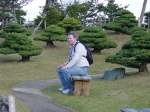New shohin JBP
+3
bonsaikc
William Feldman
daviddunn
7 posters
Page 1 of 1
 New shohin JBP
New shohin JBP
I just purchased this shohin Japanese black pine and I'd like to get some input on where you think this tree should be heading. I really love something about this tree, but I think it looks "bushy" at the moment. I don't have a lot of experience dealing with pines, so I want to have a really well thought out plan.
Here is what I know about the tree:
It is approximately 40 years old, and was imported from Japan in 2005 by its previous owner.
It is six-inches from the soil, currently in a four-inch round pot.
It was last repotted in 2008, and needle work was also last done in 2008.
Thanks for the input.


Here is what I know about the tree:
It is approximately 40 years old, and was imported from Japan in 2005 by its previous owner.
It is six-inches from the soil, currently in a four-inch round pot.
It was last repotted in 2008, and needle work was also last done in 2008.
Thanks for the input.
daviddunn- Member
 Re: New shohin JBP
Re: New shohin JBP
Hey, welcome to the neighborhood! Are you in a club?
Here are my notes on Japanese Black Pines. Hope it's not too much information:
Black Pine (Bonsai Today 10-25 by Kazuo Oishi. Bonsai Today 2-58, no author given)
Candle Pinching: (Bonsai Today 10-27. Not mentioned in 2-59.)
First two weeks in May, break candles, leaving 1/2 to 1/3rd of the total length.
Candle Removal: (Bonsai Today 2-59)
Mid to late June, when spring budding has matured,
Pinch weak buds about 1/16th inch above old needles.
At the same time, pull all of the needles out of the strong buds, leaving just the sheaths.
Hans van Meer says to do this if there is a big difference in strength between the strong and the medium (he uses three) zones.
http://www.bonsaitalk.com/news/articles/000001/000176-4.htm
10 or 15 days later, new growth will begin to appear in the fascicles of the weak buds.
At this time pinch the strong buds, (which we pulled the needles out of earlier), about 1/8th inch above the old needles.
Bonsai Today 10-27 says divide into three zones, not two, and separate by a week or ten days.
Bud trimming: (Selective removal of secondary buds) (Bonsai Today 2-59)
Late July, the new buds have elongated considerably. Some are even at the point of opening their needles.
At this time, remove strong buds from strong areas, weak buds from weak areas.
Can be done by hand, but preferable to use tweezers to avoid damaging buds.
Leave 2 buds in stronger areas, 3 or 4 in weaker areas.
Bonsai Today 10-27 says divide into three zones, weak zone first and strong zone last, and separate zones by a week or ten days.
Doesn't mention removing strong buds from strong areas or weak buds from weak areas, but just says 'remove unnecessary buds'.
Remove unnecessary buds from strong areas as soon as they appear.
Do not prune buds after August.
Needle thinning:
Bonsai Today 2-59 says:
In October, when old needles begin to take on a reddish color before falling,
Pull out the old needles, (the ones we had previously left at the base of the pinched buds), with tweezers.
Don't pull needles in areas where weíre hoping for adventitious buds.
In December, remove some of the new needles.
In strong areas, leave only 3 or 4 pairs.
In weak areas leave 5 or 6 pairs.
Don't touch the very weak areas.
Bonsai Today 10-26 says:
October to February, divide tree into three parts.
Pull out quite a number of needles in the strong zone.
Remove little more than the old needles in the medium zone.
Remove very few or perhaps none of the needles in the weak zones, (generally the low branches and the inner portions of branches).
March, For an established tree, pull needles leaving only three needle pairs around each shoot of medium and strong vigor.
Do it when budding is going to begin within four weeks.
If the tree has already budded, it is too late.
Very effective on already formed, dense trees.
Eliminate strong (sacrifice?) branches at apex: (Bonsai Today 2-59)
Midwinter.
Second year, late April, if there is still an imbalance between weak areas and strong areas: (Bonsai Today 2-59)
Cut all the little branches that are strong from the areas of strong growth.
Cut all the small branches that are weak from the weaker, leaving the strongest.
Second year, mid July, if the little branches at the apex are still too vigorous: (Bonsai Today 2-59)
Use scissors to remove growth at the apex:
From the longest branches, cut just below the level of the new needles.
From the medium ones leave about half.
Cut the weakest ones level with the trunk.
Second year mid August, remove unwanted secondary buds. (Bonsai Today 2-59)
Third year and later: (Bonsai Today 2-59)
Pinching and needle removal should be done every year.
Selective removal of secondary buds should be done every 2 or 3 years.
Brent Walston describes John Naka's technique for maintaining potential final (non-sacrifice) branches on black pines in development:
Mid to late June, ("mid-season"), you remove all the candles longer than one inch.
To get the timing right, you have to look at the growth of the previous season. The timing is such that you want to remove the PRIMARY growth in order to stimulate SECONDARY growth or candles that will expand into short shoots of desirable length before growth stops in the fall. If the secondary growth is too long, you candled too early, if it is too short, you candled too late. Now, you read lots of crap about 'balancing energy' in pines. While this may technically be true, most of the people spouting it haven't a clue what is really happening in the plant. You will also read a lot about weak plants versus strong plants and top areas versus lower areas, all true for those $5,000 trees, quite meaningless for healthy non root bound pines in training.
Part two of Naka's method is to reduce node (whorl) branches to TWO in November, or winter; timing doesn't matter much. One of these branches (both are usually secondary growth) will be the branch extension (usually the longer of the two), and the shorter one will be the side branch. I do have one corollary to Naka's rule, I always remove the terminal bud candle during the summer no matter how long it is because I don't want branch growth to be straight.
If you need back budding, such as to give you a way of shortening a long internode, the best thing to do is to let the terminal shoot grow wild for a year or two. The long internode has a very good chance of giving you one or more internodal buds if it is only three years old (still has needles). When this section is three years old, you remove the all of the rest of the growth beyond the node at the end of the long internode. To play it safe, you can leave one short branch at this node. To go for broke you can remove the node (but you may lose the internode). There are three schools of thought about when to do this. The first and oldest (safest) says to do it in late winter. The second says to do it in fall (remove all the current season's growth). I say to do it in mid season, when you would normally do your candling. I prefer this method because the trees are very active and will form buds and new short growth in only three weeks time. It's quite amazing. This may not be suitable for growers with very short growing seasons.
The last note I want to leave you with is that you can easily overwork and weaken pines. Therefor I recommend a hard pruning year followed by a maintenance only year, which give them a rest, but doesn't allow enough growth for them to go wild. In hard pruning years, you remove candles as well as remove sacrifices, hitting them hard to promote back budding. In maintenance years you candle only.
http://www.bonsaichat.net/dynamics/showentry.php?e=48
Here are my notes on Japanese Black Pines. Hope it's not too much information:
Black Pine (Bonsai Today 10-25 by Kazuo Oishi. Bonsai Today 2-58, no author given)
Candle Pinching: (Bonsai Today 10-27. Not mentioned in 2-59.)
First two weeks in May, break candles, leaving 1/2 to 1/3rd of the total length.
Candle Removal: (Bonsai Today 2-59)
Mid to late June, when spring budding has matured,
Pinch weak buds about 1/16th inch above old needles.
At the same time, pull all of the needles out of the strong buds, leaving just the sheaths.
Hans van Meer says to do this if there is a big difference in strength between the strong and the medium (he uses three) zones.
http://www.bonsaitalk.com/news/articles/000001/000176-4.htm
10 or 15 days later, new growth will begin to appear in the fascicles of the weak buds.
At this time pinch the strong buds, (which we pulled the needles out of earlier), about 1/8th inch above the old needles.
Bonsai Today 10-27 says divide into three zones, not two, and separate by a week or ten days.
Bud trimming: (Selective removal of secondary buds) (Bonsai Today 2-59)
Late July, the new buds have elongated considerably. Some are even at the point of opening their needles.
At this time, remove strong buds from strong areas, weak buds from weak areas.
Can be done by hand, but preferable to use tweezers to avoid damaging buds.
Leave 2 buds in stronger areas, 3 or 4 in weaker areas.
Bonsai Today 10-27 says divide into three zones, weak zone first and strong zone last, and separate zones by a week or ten days.
Doesn't mention removing strong buds from strong areas or weak buds from weak areas, but just says 'remove unnecessary buds'.
Remove unnecessary buds from strong areas as soon as they appear.
Do not prune buds after August.
Needle thinning:
Bonsai Today 2-59 says:
In October, when old needles begin to take on a reddish color before falling,
Pull out the old needles, (the ones we had previously left at the base of the pinched buds), with tweezers.
Don't pull needles in areas where weíre hoping for adventitious buds.
In December, remove some of the new needles.
In strong areas, leave only 3 or 4 pairs.
In weak areas leave 5 or 6 pairs.
Don't touch the very weak areas.
Bonsai Today 10-26 says:
October to February, divide tree into three parts.
Pull out quite a number of needles in the strong zone.
Remove little more than the old needles in the medium zone.
Remove very few or perhaps none of the needles in the weak zones, (generally the low branches and the inner portions of branches).
March, For an established tree, pull needles leaving only three needle pairs around each shoot of medium and strong vigor.
Do it when budding is going to begin within four weeks.
If the tree has already budded, it is too late.
Very effective on already formed, dense trees.
Eliminate strong (sacrifice?) branches at apex: (Bonsai Today 2-59)
Midwinter.
Second year, late April, if there is still an imbalance between weak areas and strong areas: (Bonsai Today 2-59)
Cut all the little branches that are strong from the areas of strong growth.
Cut all the small branches that are weak from the weaker, leaving the strongest.
Second year, mid July, if the little branches at the apex are still too vigorous: (Bonsai Today 2-59)
Use scissors to remove growth at the apex:
From the longest branches, cut just below the level of the new needles.
From the medium ones leave about half.
Cut the weakest ones level with the trunk.
Second year mid August, remove unwanted secondary buds. (Bonsai Today 2-59)
Third year and later: (Bonsai Today 2-59)
Pinching and needle removal should be done every year.
Selective removal of secondary buds should be done every 2 or 3 years.
Brent Walston describes John Naka's technique for maintaining potential final (non-sacrifice) branches on black pines in development:
Mid to late June, ("mid-season"), you remove all the candles longer than one inch.
To get the timing right, you have to look at the growth of the previous season. The timing is such that you want to remove the PRIMARY growth in order to stimulate SECONDARY growth or candles that will expand into short shoots of desirable length before growth stops in the fall. If the secondary growth is too long, you candled too early, if it is too short, you candled too late. Now, you read lots of crap about 'balancing energy' in pines. While this may technically be true, most of the people spouting it haven't a clue what is really happening in the plant. You will also read a lot about weak plants versus strong plants and top areas versus lower areas, all true for those $5,000 trees, quite meaningless for healthy non root bound pines in training.
Part two of Naka's method is to reduce node (whorl) branches to TWO in November, or winter; timing doesn't matter much. One of these branches (both are usually secondary growth) will be the branch extension (usually the longer of the two), and the shorter one will be the side branch. I do have one corollary to Naka's rule, I always remove the terminal bud candle during the summer no matter how long it is because I don't want branch growth to be straight.
If you need back budding, such as to give you a way of shortening a long internode, the best thing to do is to let the terminal shoot grow wild for a year or two. The long internode has a very good chance of giving you one or more internodal buds if it is only three years old (still has needles). When this section is three years old, you remove the all of the rest of the growth beyond the node at the end of the long internode. To play it safe, you can leave one short branch at this node. To go for broke you can remove the node (but you may lose the internode). There are three schools of thought about when to do this. The first and oldest (safest) says to do it in late winter. The second says to do it in fall (remove all the current season's growth). I say to do it in mid season, when you would normally do your candling. I prefer this method because the trees are very active and will form buds and new short growth in only three weeks time. It's quite amazing. This may not be suitable for growers with very short growing seasons.
The last note I want to leave you with is that you can easily overwork and weaken pines. Therefor I recommend a hard pruning year followed by a maintenance only year, which give them a rest, but doesn't allow enough growth for them to go wild. In hard pruning years, you remove candles as well as remove sacrifices, hitting them hard to promote back budding. In maintenance years you candle only.
http://www.bonsaichat.net/dynamics/showentry.php?e=48
Last edited by William Feldman on Thu Feb 18, 2010 4:29 am; edited 1 time in total (Reason for editing : Make headings bold to improve readability)

William Feldman- Member
 Re: New shohin JBP
Re: New shohin JBP
Looks like posting the info removed all the indentation. I hope it's still readable.

William Feldman- Member
 Re: New shohin JBP
Re: New shohin JBP
Thank you very much, that is very useful info. Do you have any input with regards to the overall styling of this tree? Thanks again.
daviddunn- Member
 Re: New shohin JBP
Re: New shohin JBP
Nobody has any input about the current style, or weaknesses with this tree?
daviddunn- Member
 Re: New shohin JBP
Re: New shohin JBP
Okay, I'll jump in.
The apex and the branch going farthest to the right look like they have been allowed to grow too long with no ramification. They might have to be removed, since they probably won't produce any new buds near the trunk. (The portion near the trunk won't sprout new buds because it doesn't have any needles.)
I would recommend wiring the branches into horizontal or slightly downward-pointing positions as much as possible, and then concentrating on increasing the density and decreasing the needle length by following the instructions I posted earlier. The challenge will be keeping the growth compact, like in these trees from the Ueno Green Club:


The apex and the branch going farthest to the right look like they have been allowed to grow too long with no ramification. They might have to be removed, since they probably won't produce any new buds near the trunk. (The portion near the trunk won't sprout new buds because it doesn't have any needles.)
I would recommend wiring the branches into horizontal or slightly downward-pointing positions as much as possible, and then concentrating on increasing the density and decreasing the needle length by following the instructions I posted earlier. The challenge will be keeping the growth compact, like in these trees from the Ueno Green Club:



William Feldman- Member
 Re: New shohin JBP
Re: New shohin JBP
Thanks for the input. I was looking at your photos earlier, I would love to work on getting that kind of ramification on my tree.
daviddunn- Member
 Re: New shohin JBP
Re: New shohin JBP
David,
You have an excellent piece of material here that looks like it could be ready to show in three years or so, if it's healthy and strong. Boon has been working with JBP for some time and has simplified that process so much that one need not worry excessively about results. They will come if you keep the tree healthy. I wrote an article on it called "Needle Therapy" and will be glad to PM you with it.
I also recommend Boon's JBP DVD...He does a fantastic job describing technique for both young JBP in training and mature trees.
These branches all look very young and as such should easily back bud for you with proper candling technique. Candling is not just for needle reduction, although it can be used for that. It increases ramification, and if done with proper timing, gives you two seasons' growth in one year...on a healthy tree. Yours looks healthy and strong, so you should have fun with it.
Can you show us photos from more directions?
Chris
You have an excellent piece of material here that looks like it could be ready to show in three years or so, if it's healthy and strong. Boon has been working with JBP for some time and has simplified that process so much that one need not worry excessively about results. They will come if you keep the tree healthy. I wrote an article on it called "Needle Therapy" and will be glad to PM you with it.
I also recommend Boon's JBP DVD...He does a fantastic job describing technique for both young JBP in training and mature trees.
These branches all look very young and as such should easily back bud for you with proper candling technique. Candling is not just for needle reduction, although it can be used for that. It increases ramification, and if done with proper timing, gives you two seasons' growth in one year...on a healthy tree. Yours looks healthy and strong, so you should have fun with it.
Can you show us photos from more directions?
Chris

bonsaikc- Member
 Re: New shohin JBP
Re: New shohin JBP
Where can one get Boons' DVD
thanks Tom
thanks Tom
bonsaikc wrote:David,
You have an excellent piece of material here that looks like it could be ready to show in three years or so, if it's healthy and strong. Boon has been working with JBP for some time and has simplified that process so much that one need not worry excessively about results. They will come if you keep the tree healthy. I wrote an article on it called "Needle Therapy" and will be glad to PM you with it.
I also recommend Boon's JBP DVD...He does a fantastic job describing technique for both young JBP in training and mature trees.
These branches all look very young and as such should easily back bud for you with proper candling technique. Candling is not just for needle reduction, although it can be used for that. It increases ramification, and if done with proper timing, gives you two seasons' growth in one year...on a healthy tree. Yours looks healthy and strong, so you should have fun with it.
Can you show us photos from more directions?
Chris

Tom McCue- Member
 Update
Update
I'm very pleased with the way this tree turned out, I'm really looking forward to seeing it after 1-2 years of good needle maintenance. Sorry for the low quality photos, I just snapped these today with my mobile phone. Feedback is always welcome!


Front

Right Side

Back

Left Side

Top
Front
Right Side
Back
Left Side
Top
daviddunn- Member
 Re: New shohin JBP
Re: New shohin JBP
Great job wiring! I'd really like to see some follow up photos in the future. Btw, if you don't mind me asking what was the final bid on the tree, I saw it on e-bay.
hibonsai- Member
 Re: New shohin JBP
Re: New shohin JBP
I believe your Japanese Black Pine (i guess JBP stands for) should give up smoking. He seems weak, with very few needles, as if he was looking for oxygen.
Don't mind what I'm saying, I'm just kidding of course. Very nice tree.
But maybe needs new soil and a bit of fertiliser...
Don't mind what I'm saying, I'm just kidding of course. Very nice tree.
But maybe needs new soil and a bit of fertiliser...

AlainK- Member
 Re: New shohin JBP
Re: New shohin JBP
AlainK wrote:I believe your Japanese Black Pine (i guess JBP stands for) should give up smoking. He seems weak, with very few needles, as if he was looking for oxygen.
Don't mind what I'm saying, I'm just kidding of course. Very nice tree.
But maybe needs new soil and a bit of fertiliser...
Interesting post... Thanks for the input.
daviddunn- Member
 Similar topics
Similar topics» When is a shohin no longer a shohin
» Photos from the British Shohin Association’s 'Shohin Off' weekend event 2011
» Shohin Yew
» Some Shohin
» ASPAC Takamatsu Japan 2011 and BCI Tour
» Photos from the British Shohin Association’s 'Shohin Off' weekend event 2011
» Shohin Yew
» Some Shohin
» ASPAC Takamatsu Japan 2011 and BCI Tour
Page 1 of 1
Permissions in this forum:
You cannot reply to topics in this forum






